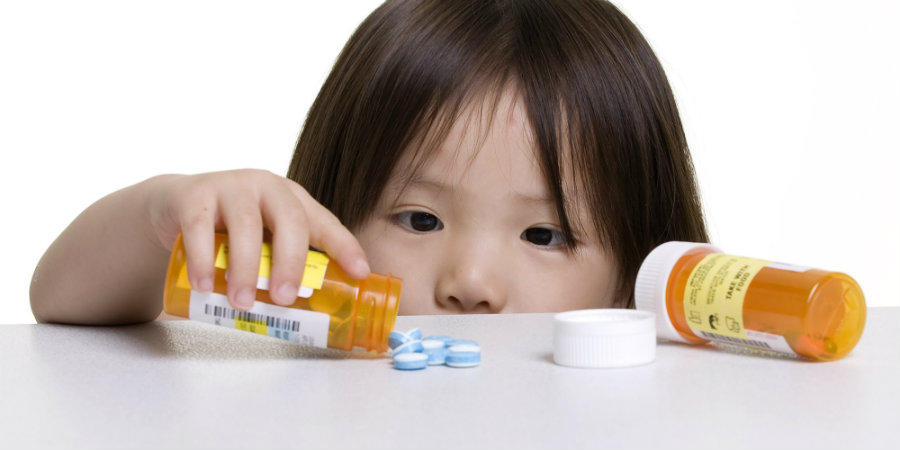More than 13,000 children were poisoned 1997 to 2012 by taking opioid pills intended for adults in their households. This means that hospitalization for pediatric opioid poisonings almost doubled during that period. An analysis published Monday in JAMA Pediatrics revealed that the highest hospitalization rates occurred among those aged 15 to 24 years while the rate for kids aged 1 to 4 increased the most as it doubled over time.
Of 13,052 children hospitalized for poisonings from opioid prescriptions, 176 died. Oxycodone, Percocet, and codeine were the most common drugs involved. Report author Julie R. Gaither compared this problem with gun safety and remarked the importance of keeping guns and opioid pills out of the reach of children. She is an epidemiologist at the Yale School of Medicine who also studies pediatric injuries caused by firearms.

“These children are getting into their parents’ or grandparents’ medication. Opioids are now ubiquitous in millions of U.S. homes,” Gaither said in an interview, as quoted by The Washington Post. “They are like guns — you have these dangerous things, and we need to keep [them] out of the hands of the most vulnerable.”
Gaither was surprised by the numbers the analysis revealed as drugs are killing more Americans than guns and car accidents. As retail sales of prescription opioids increased from 1999 to 2010, deaths caused by opioid overdose rose fourfold among people from 15 to 64 years old.
The analysis shows that there were few cases of poisonings among children ages 5 to 9, who usually can tell potentially dangerous pills apart from candy. Gaither said this is the only age not alarmingly affected by poisonings and that these incidents were most likely accidental in the youngest groups. In contrast, poisonings among teenagers were mainly linked to suicide.
Doctors could play a significant role in reducing children exposure to opioids
The study authors wrote that their findings highlight the widespread availability of prescription drugs and the threats it poses, particularly for teenagers at risk for depression.
There is a carelessness by parents and other adults near children as they fail at keeping them away from the pills, said Gaither. The report author noted that doctors who prescribe opioids should make sure their patients have a safety plan, so their children are not exposed to the drugs.
The research team analyzed US pediatric hospital discharge for more than 13,000 hospitalizations from January 1, 1997, through December 31, 2012. The researchers looked closely at cases of poisonings as a result of methadone consume given that this drug is often linked to a disproportionate number of poisonings even though prescription rates for this component are little. The analysis showed that methadone poisonings among teenagers aged 15 to 19 increased 950 percent.
“Methadone is among the most misused of prescription drugs and is commonly diverted for illicit (nonmedical) purposes, such as getting high or to enhance the effects of alcohol or other drugs,” the researchers wrote in the paper.
The annual incidence of hospitalizations for opioid poisonings increased 165 percent during the 16-year study period. As much as 73.5 percent of the victims are white, and 53 percent are female. The authors pointed out in the paper that opioids have played a significant role in the decline in life expectancy among white women in their parents’ generation.
Solutions: Researchers’ advice
The authors noted that the medical community should improve efforts to address opioid misuse and abuse by adolescents and launch prevention programs to fight depression among this vulnerable group.
Dr. Gaither said in a podcast that comprehensive strategies are needed to reduce the effects of prescription opioid exposure and that efforts must be focused on storage, packaging, and misuse, according to a report by Medscape. Gaither also remarked the importance of educating prescribers and patients on the matter.
However, she highlighted the fact that one thing is for parents to keep their children’s hands off opioid pills and another actually difficult was for those parents to keep their kids safe when they themselves are abusing those drugs, and that makes them unable to protect their little ones.
Gaither mentioned recent stories on social media and in the news that could serve as a wake-up call to adults to seek medical help. The toll of the epidemic of opioid abuse in Americans has been reflected in real-life stories of little kids trapped in the middle of horrifying situations in which their parents suffer from overdoses.
Those incidents covered by the media in the past few months have called the attention of pediatricians who have raised awareness on the importance of improved psychological counseling to keep the children of addicts safe.
Source: JAMA
